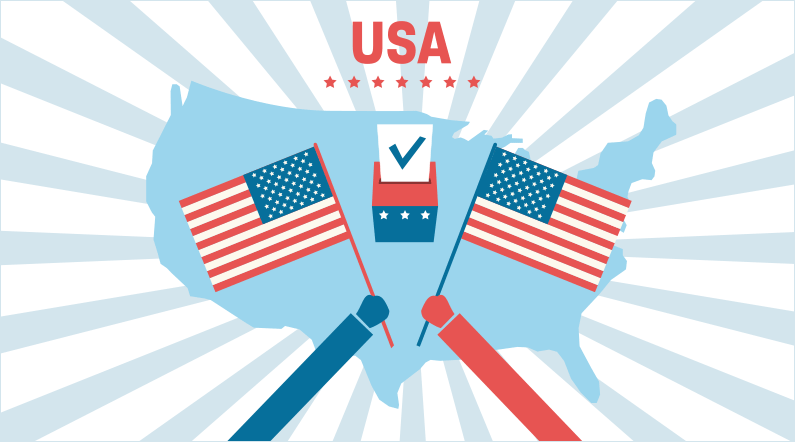The recent Presidential election will be analyzed on every dimension. Regardless of which side of the political spectrum one falls, a cursory look at candidate/campaign branding and marketing suggests why Donald Trump’s message resonated with a core audience. Focusing on core target audience is what all good brand marketers must do to be successful. We’ve taken a look at each candidate’s branding and marketing strategy and here are some of our key takeaways.
Make America Great Again vs. Stronger Together
If you boil each campaign’s brand positioning to its core brand promise – Donald Trump’s primary slogan to “Make America Great Again” resonated deeply with many Americans. First, “Make America Great” is the desire of all American’s and everyone has their own definition of “greatness” (e.g., American Dream, compassion, liberty, etc.). The twist in his slogan is the word “again”, which allows every voter to imagine a point that America was great for them – whether the 1970’s or 2016. Trump later introduced a secondary slogan “Drain the swamp”, which targeted perceived corruption in Washington, D.C. Importantly, both slogans were focused on change. “Change” is defined by each voter on their terms, while not being a vision for the country. That’s why many Trump supporters were so enthusiastic about his brand messaging.
Hillary Clinton’s brand was much softer. Her slogan “Stronger Together” didn’t resonate because it wasn’t anchored to America or a stronger promise like Trump’s “Make America Great Again”. Additionally, Clinton’s “I’m with Her” strongly tied her to being the first female Presidential candidate representing either major party. However, outside of being the first female candidate, it didn’t provide a “personal” reason for a voter to vote for her.
In this election, voters had the choice of two candidates with significant negative brand associations and likeability issues. While many negative brand associations are difficult to overcome for any brand, sometimes context triumphs. Change from the outside was such a powerful motivator in this election that Trumps voters ignored a myriad of negative brand associations that would have otherwise hurt most other candidates.
Consumer Brand Analogy: Sony vs. Samsung
To tie this back to brands everyone is familiar with, let’s look at Sony and Samsung. Over the last decade, Sony has fallen from #20 to #58 in Interbrand’s Top 100 Global Brands study, while Samsung (pre-spontaneously combusting cell phones) rose from not even being on the list to the 7th most valuable brand in the world. Why? Well, in part it’s due to their most recent brand messaging. Sony’s “Make Believe”, which was recently retired, was vague and didn’t inspire certainty. Consumers spend a lot on consumer electronics and they want to make sure they have products that are not whimsical. GE uses a similar construct to much greater effect with “Imagination at Work”. GE’s promise is applied creativity. Sony’s tagline made no sense.
Conversely, Samsung was effective at displacing Sony and cutting into Apple’s share, with the tagline “The Next Big Thing”. This is a clear customer promise that innovations from Samsung are important and will be game changing. Samsung’s rise to brand prominence and dominance was because they spoke to consumers directly, set a level of expectation and delivered.
Election Marketing Execution
Great brands are built through strong marketing execution. Brands that execute well receive a multiplier effect from customer momentum – like Apple. Samsung came out of nowhere to dethrone Sony. A lot will be discussed about what each candidate did right or wrong in their marketing plan execution. Every aspect of the marketing plan will be dissected – media strategy, social media messaging, the use of social media channels, response to crisis, etc. Great marketing execution is focused on smart planning and sweating the details. One statistic that was interesting was the number of rallies both candidates attended over the last two weeks of the campaign. Trump went to 133 and Clinton went to 87. And with the way Trump leveraged free media, this provided his campaign a strong multiplier effect with his core target audience. As with any campaign, even ones where one candidate won by a large margin, polls tend to tighten in the last two weeks of the race. This is where Trump’s clearer brand message helped him shift enough voters to eke out victories in four traditionally Blue states.
Final Thoughts
The bottom line is that marketers understand that while strong brand positioning and marketing execution can help drive trial, “repeat purchase” is earned when the product or service meets or exceeds customer expectations. That’s why there is a lot of disappointment in politics – politicians overpromise and under deliver. Brands can’t operate this way or they won’t be in the market for long. Several promises made by Trump in this election were very specific (the Wall, etc.) and, in his words – “huge”; we’ll see if after trying the Trump brand, America will be up for a repeat purchase…
Let us know your thoughts or perspective on branding in politics.


Recent Comments